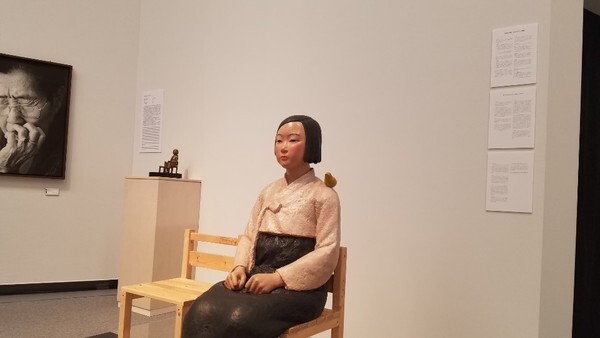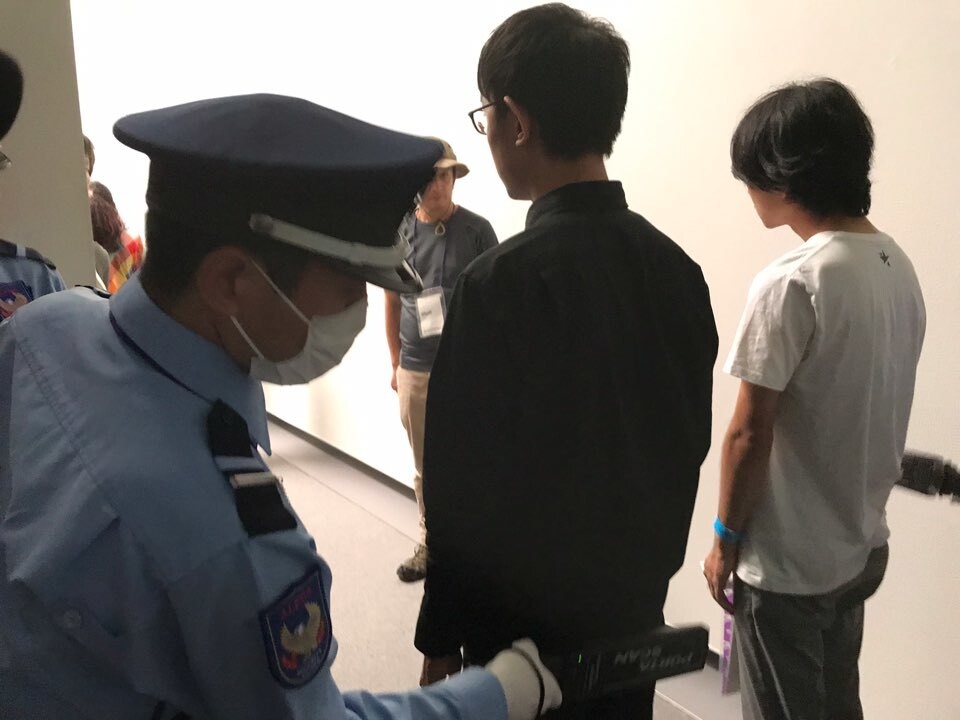hankyoreh
Links to other country sites 다른 나라 사이트 링크
Comfort woman statue exhibit reopens during Aichi Triennale

“I’m really glad that the [comfort woman statue] exhibition will be reopened, even if just for one week. This was made possible by the rallies held and signatures collected by the citizens,” a Japanese woman in her 70s calmly said.
She viewed “Statue of a Girl of Peace” on the eighth floor of the Aichi Culture and Arts Center, in Nagoya, Aichi Prefecture, Japan, on Oct. 8.
When the exhibition reopened on Oct. 8, the woman overcame 23-to-1 odds to get a ticket.
“When I heard that ‘Statue of a Girl of Peace’ was going on display [in August], I tried to see it, but the exhibition sadly shut down just three days later,” she said.

On Tuesday, Aichi Prefecture reopened the exhibition “After ‘Freedom of Expression?’” which includes the comfort women statue.
The prefecture had unveiled the exhibition as part of the Aichi Triennale, Japan’s largest international art festival, on Aug. 1, but shut the exhibition down three days later, on Aug. 3, after it came under attack from Japan’s right wing.
At 1:30 pm on Tuesday, the entire 10th floor of the arts center was encircled by a long line of people hoping to see the exhibition. The prefecture selected two groups of 30 people, to be admitted at 2:10 pm and 4:20 pm, through a lottery. The first drawing attracted 709 participants, the second 649. The people selected were given a stamp on the wristband used in the drawing, and they gleefully showed off the stamp to their friends.
The prefecture has only reopened the exhibition on a limited base, while imposing some strict conditions. Visitors must pass through a metal detector, and they can only bring their valuables with them; any other possessions must be deposited with the staff. Visitors are taken through the exhibition by a guide, with time allotted for discussion. As a result, only 15 minutes of the hour in the exhibition is reserved for independent viewing. The press is also prohibited from going into the exhibition.
The comfort woman statue exhibition “became a huge controversy in Japan,” explained a 23-year-old university student who was standing in line to take part in the ticket drawing.
“I feel like the very debate we’ve had is subjecting the women to sexual violence for a second time,” the student said.
“I came to show my support for the freedom of expression. I’m not sure if the comfort woman statue has any artistic significance or not, but there’s no reason to shut it down,” said Shizue Yasui, 59, a citizen of Nagoya.

Japan’s public officials who opposed the exhibit
Members of Japan’s far right weren’t the only people pressuring the prefecture to halt the comfort women statue exhibition. The Japanese administration, under Prime Minister Shinzo Abe, refused to pay 78 million yen (US$727,818) in government subsidies to the triennale on the grounds that it hadn’t provided enough details when it applied for the subsidy.
Nagoya Mayor Takashi Kawamura, who has claimed that the comfort women statue exhibition “injured the feelings of the Japanese,” staged sit-ins on Tuesday in front of the arts center and in front of the Aichi provincial office to express his opposition to the reopening of the exhibition.
While there had been relentless pressure from public officials to keep the exhibition closed, Japanese citizens were just as persistent in their campaign, which ultimately bore fruit in the reopening of the exhibition, albeit on a limited scale. Some 10,000 people signed a petition to reopen the exhibition.
“We can’t deny the harm done to the comfort women. The problem is that people don’t feel comfortable openly talking about this. People ought to feel okay about going around in a T-shirt about the comfort women,” said Masaami Takahiro, one of the individuals who viewed the exhibition after being selected in the lottery.
“I’m glad that we’ve come so far on this difficult journey. I want to show the exhibition to as many people as possible,” said Yuka Okamoto, a member of the exhibition’s executive committee.
By Cho Ki-weon, Tokyo correspondent
Please direct comments or questions to [english@hani.co.kr]

Editorial・opinion
![[Column] Park Geun-hye déjà vu in Yoon Suk-yeol [Column] Park Geun-hye déjà vu in Yoon Suk-yeol](https://flexible.img.hani.co.kr/flexible/normal/500/300/imgdb/original/2024/0424/651713945113788.jpg) [Column] Park Geun-hye déjà vu in Yoon Suk-yeol
[Column] Park Geun-hye déjà vu in Yoon Suk-yeol![[Editorial] New weight of N. Korea’s nuclear threats makes dialogue all the more urgent [Editorial] New weight of N. Korea’s nuclear threats makes dialogue all the more urgent](https://flexible.img.hani.co.kr/flexible/normal/500/300/imgdb/original/2024/0424/7317139454662664.jpg) [Editorial] New weight of N. Korea’s nuclear threats makes dialogue all the more urgent
[Editorial] New weight of N. Korea’s nuclear threats makes dialogue all the more urgent- [Guest essay] The real reason Korea’s new right wants to dub Rhee a founding father
- [Column] ‘Choson’: Is it time we start referring to N. Korea in its own terms?
- [Editorial] Japan’s rewriting of history with Korea has gone too far
- [Column] The president’s questionable capacity for dialogue
- [Column] Are chaebol firms just pizza pies for families to divvy up as they please?
- [Column] Has Korea, too, crossed the Rubicon on China?
- [Correspondent’s column] In Japan’s alliance with US, echoes of its past alliances with UK
- [Editorial] Does Yoon think the Korean public is wrong?
Most viewed articles
- 1‘We must say no’: Seoul defense chief on Korean, USFK involvement in hypothetical Taiwan crisis
- 2N. Korean delegation’s trip to Iran shows how Pyongyang is leveraging ties with Moscow
- 3Amnesty notes ‘erosion’ of freedom of expression in Korea in annual human rights report
- 4[Column] Park Geun-hye déjà vu in Yoon Suk-yeol
- 5‘Weddingflation’ breaks the bank for Korean couples-to-be
- 6[Reportage] On US campuses, student risk arrest as they call for divestment from Israel
- 7[Guest essay] The real reason Korea’s new right wants to dub Rhee a founding father
- 8[Editorial] New weight of N. Korea’s nuclear threats makes dialogue all the more urgent
- 9Will NewJeans end up collateral damage in internal feud at K-pop juggernaut Hybe?
- 10Why Korea shouldn’t welcome Japan’s newly beefed up defense cooperation with US